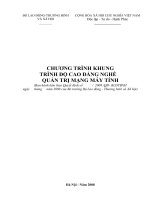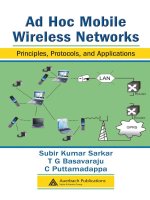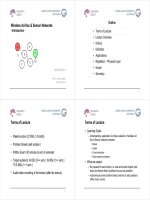Mạng không dây potx
Bạn đang xem bản rút gọn của tài liệu. Xem và tải ngay bản đầy đủ của tài liệu tại đây (6.31 MB, 334 trang )
Ad Hoc Mobile
Wireless Networks
AU6221_C000.indd 1 9/21/07 4:31:08 AM
Architecting the Telecommunication
Evolution: Toward Converged Network
Services
Vijay K. Gurbani and Xian-He Sun
ISBN: 0-8493-9567-4
Business Strategies for the
Next-Generation Network
Nigel Seel
ISBN: 0-8493-8035-9
Chaos Applications in Telecommunications
Peter Stavroulakis
ISBN: 0-8493-3832-8
Context-Aware Pervasive Systems:
Architectures for a New Breed of
Applications
Seng Loke
ISBN: 0-8493-7255-0
Fundamentals of DSL Technology
Philip Golden, Herve Dedieu, Krista S Jacobsen
ISBN: 0-8493-1913-7
Introduction to Mobile Communications:
Technology,, Services, Markets
Tony Wakefield, Dave McNally, David Bowler,
Alan Mayne
ISBN: 1-4200-4653-5
IP Multimedia Subsystem: Service
Infrastructure to Converge NGN,
3G and the Internet
Rebecca Copeland
ISBN: 0-8493-9250-0
MPLS for Metropolitan Area Networks
Nam-Kee Tan
ISBN: 0-8493-2212-X
Performance Modeling and Analysis of
Bluetooth Networks: Polling,
Scheduling, and Traffic Control
Jelena Misic and Vojislav B Misic
ISBN: 0-8493-3157-9
A Practical Guide to Content
Delivery Networks
Gilbert Held
ISBN: 0-8493-3649-X
Resource, Mobility, and Security
Management in Wireless Networks
and Mobile Communications
Yan Zhang, Honglin Hu, and Masayuki Fujise
ISBN: 0-8493-8036-7
Security in Distributed, Grid, Mobile,
and Pervasive Computing
Yang Xiao
ISBN: 0-8493-7921-0
TCP Performance over
UMTS-HSDPA Systems
Mohamad Assaad and Djamal Zeghlache
ISBN: 0-8493-6838-3
Testing Integrated QoS of VoIP:
Packets to Perceptual Voice Quality
Vlatko Lipovac
ISBN: 0-8493-3521-3
The Handbook of Mobile Middleware
Paolo Bellavista and Antonio Corradi
ISBN: 0-8493-3833-6
Traffic Management in IP-Based
Communications
Trinh Anh Tuan
ISBN: 0-8493-9577-1
Understanding Broadband over
Power Line
Gilbert Held
ISBN: 0-8493-9846-0
Understanding IPTV
Gilbert Held
ISBN: 0-8493-7415-4
WiMAX: A Wireless Technology
Revolution
G.S.V. Radha Krishna Rao, G. Radhamani
ISBN: 0-8493-7059-0
WiMAX: Taking Wireless to the MAX
Deepak Pareek
ISBN: 0-8493-7186-4
Wireless Mesh Networking:
Architectures, Protocols
and Standards
Yan Zhang, Jijun Luo and Honglin Hu
ISBN: 0-8493-7399-9
Wireless Mesh Networks
Gilbert Held
ISBN: 0-8493-2960-4
AUERBACH PUBLICATIONS
www.auerbach-publications.com
To Order Call: 1-800-272-7737 • Fax: 1-800-374-3401
E-mail:
OTHER TELECOMMUNICATIONS BOOKS FROM AUERBACH
AU6221_C000.indd 2 9/21/07 4:31:09 AM
New York London
Ad Hoc Mobile
Wireless Networks
Subir Kumar Sarkar
T G Basavaraju
C Puttamadappa
Principles, Protocols, and Applications
AU6221_C000.indd 3 9/21/07 4:31:09 AM
Auerbach Publications
Taylor & Francis Group
6000 Broken Sound Parkway NW, Suite 300
Boca Raton, FL 33487‑2742
© 2008 by Taylor & Francis Group, LLC
Auerbach is an imprint of Taylor & Francis Group, an Informa business
No claim to original U.S. Government works
Printed in the United States of America on acid‑free paper
10 9 8 7 6 5 4 3 2 1
International Standard Book Number‑13: 978‑1‑4200‑6221‑2 (Hardcover)
This book contains information obtained from authentic and highly regarded sources. Reprinted
material is quoted with permission, and sources are indicated. A wide variety of references are
listed. Reasonable efforts have been made to publish reliable data and information, but the author
and the publisher cannot assume responsibility for the validity of all materials or for the conse‑
quences of their use.
Except as permitted under U.S. Copyright Law, no part of this book may be reprinted, reproduced,
transmitted, or utilized in any form by any electronic, mechanical, or other means, now known or
hereafter invented, including photocopying, microfilming, and recording, or in any information
storage or retrieval system, without written permission from the publishers.
For permission to photocopy or use material electronically from this work, please access www.
copyright.com ( or contact the Copyright Clearance Center, Inc. (CCC)
222 Rosewood Drive, Danvers, MA 01923, 978‑750‑8400. CCC is a not‑for‑profit organization that
provides licenses and registration for a variety of users. For organizations that have been granted a
photocopy license by the CCC, a separate system of payment has been arranged.
Trademark Notice: Product or corporate names may be trademarks or registered trademarks, and
are used only for identification and explanation without intent to infringe.
Library of Congress Cataloging‑in‑Publication Data
Sarkar, Kumar.
Ad hoc mobile wireless networks : principles, protocols, and applications /
Subir Kumar Sarkar, T. G. Basavaraju, and C. Puttamadappa.
p. cm.
Includes bibliographical references and index.
ISBN 978‑1‑4200‑6221‑2 (alk. paper)
1. Wireless communication systems‑‑Quality control. 2. Internetworking
(Telecommunication) I. Basavaraju, T. G. II. Puttamadappa, C. III. Title.
TK5103.2.S27 2007
621.384‑‑dc22 2007020021
Visit the Taylor & Francis Web site at
and the Auerbach Web site at
rbach‑publications.com
AU6221_C000.indd 4 9/21/07 4:31:10 AM
v
Contents
Preface xvii
About the Authors
xix
1 Introduction 1
1.1 Fundamentals of Wireless Networks
1
1.1.1 Bluetooth 2
1.1.2 IrDA 3
1.1.2.1 Comparison of Bluetooth and IrDA
3
1.1.3 HomeRF 4
1.1.3.1 Comparison of Bluetooth with Shared
Wireless Access Protocol (SWAP)
5
1.1.4 802.11 (WiFi)
7
1.1.5 802.16 (WiMax)
7
1.1.6 Hotspots 8
1.1.7 Mesh Networking
8
1.1.7.1 Limitation of Wireless Technology
9
1.2 Wireless Internet
9
1.2.1 IP Limitations
11
1.2.2 Mobile Internet Protocol (IP)
11
1.2.2.1 Working of Mobile IP
12
1.2.3 Discovering the Care-of Address
15
1.2.4 Registering the Care-of Address
16
1.2.5 Authentication 17
1.2.6 Automatic Home Agent Discovery
18
1.2.7 Tunneling to the Care-of Address
18
1.2.8 Issues in Mobile IP
19
1.2.8.1 Routing Inefficiencies
19
1.2.8.2 Security Issues
19
1.2.8.3 Ingress Filtering
20
1.2.8.4 User Perceptions of Reliability
20
1.2.8.5 Issues in IP Addressing
20
AU6221_C000.indd 5 9/21/07 4:31:11 AM
vi � Contents
1.2.8.6 Slow Growth in the Wireless Local Area
Network (LAN) Market
21
1.2.8.7 Competition from Other Protocols
21
1.3 What Are Ad Hoc Networks?
21
1.3.1 Differences between Cellular and Ad Hoc
Wireless Networks
23
1.3.2 Applications of Ad Hoc Wireless Networks
23
1.3.3 Technical and Research Challenges
25
1.3.3.1 Security Issues and Challenges
25
1.3.3.2 Different Types of Attacks on Multicast
Routing Protocols
26
1.3.3.3 Interconnection of Mobile Ad Hoc Networks
and the Internet
27
1.3.4 Issues in Ad Hoc Wireless Networks
27
1.3.4.1 Medium Access Control (MAC) Protocol
Research Issues
28
1.3.4.2 Networking Issues
28
1.3.4.3 Ad Hoc Routing and Forwarding
29
1.3.4.4 Unicast Routing
29
1.3.4.5 Multicast Routing
31
1.3.4.6 Location-Aware Routing
32
1.3.4.7 Transmission Control Protocol (TCP) Issues
32
1.3.4.8 Network Security
33
1.3.4.9 Different Security Attacks
33
1.3.4.10 Security at Data-Link Layer
34
1.3.4.11 Secure Routing
34
1.3.4.12 Quality of Service (QoS)
35
1.4 Problems 35
Bibliography 35
2 MAC Layer Protocols for Ad Hoc Wireless Networks 37
2.1 Introduction 37
2.2 Important Issues and the Need for Medium Access Control
(MAC) Protocols
38
2.2.1 Need for Special MAC Protocols
39
2.3 Classification of MAC Protocols
40
2.3.1 Contention-Based MAC Protocols
41
2.3.2 Contention-Based MAC Protocols with
Reservation Mechanisms
42
2.3.2.1 Multiple Access Collision Avoidance (MACA)
42
2.3.2.2 IEEE 802.11 MAC Scheme
44
2.3.2.3 Multiple Access Collision Avoidance—
by Invitation (MACA-BI)
45
AU6221_C000.indd 6 9/21/07 4:31:11 AM
Contents � vii
2.3.2.4 Group Allocation Multiple Access with
Packet Sensing (GAMA-PS)
45
2.3.3 MAC Protocols Using Directional Antennas
46
2.3.4 Multiple-Channel MAC Protocols
47
2.3.4.1 Dual Busy Tone Multiple Access (DBTMA)
48
2.3.4.2 Multichannel Carrier Sense Multiple Access
(CSMA) MAC Protocol
49
2.3.4.3 Hop-Reservation Multiple Access (HRMA)
49
2.3.4.4 Multichannel Medium Access Control
(MMAC) 50
2.3.4.5 Dynamic Channel Assignment with
Power Control (DCA-PC)
51
2.3.5 Power-Aware or Energy-Efficient MAC Protocols
51
2.3.5.1 Power-Aware Medium Access Control with
Signaling (PAMAS)
52
2.3.5.2 Dynamic Power-Saving Mechanism (DPSM)
52
2.3.5.3 Power Control Medium Access Control (PCM) 53
2.3.5.4 Power-Controlled Multiple Access (PCMA)
54
2.4 Summary 55
2.5 Problems 55
Bibliography 56
3 Routing Protocols for Ad Hoc Wireless Networks 59
3.1 Introduction 59
3.2 Design Issues of Routing Protocols for Ad Hoc Networks
60
3.2.1 Routing Architecture
60
3.2.2 Unidirectional Links Support
61
3.2.3 Usage of SuperHosts
62
3.2.4 Quality of Service (QoS) Routing
62
3.2.5 Multicast Support
63
3.3 Classification of Routing Protocols
64
3.3.1 Proactive, Reactive, and Hybrid Routing
65
3.3.2 Structuring and Delegating the Routing Task
66
3.3.3 Exploiting Network Metrics for Routing
67
3.3.4 Evaluating Topology, Destination, and Location for
Routing 67
3.4 Proactive Routing Protocols
68
3.4.1 Wireless Routing Protocol (WRP)
68
3.4.1.1 Overview 69
3.4.1.2 Information Maintained at Each Node
70
3.4.1.3 Information Exchanged among Nodes
71
3.4.1.4 Routing-Table Updating
72
AU6221_C000.indd 7 9/21/07 4:31:12 AM
viii � Contents
3.4.2 Destination-Sequenced Distance Vector (DSDV) 72
3.4.2.1 Distance Vector
72
3.4.2.2 Operating DSDV at Layer 2
77
3.4.2.3 Extending Base Station Coverage
77
3.4.3 Optimized Link State Routing (OLSR) Protocol
77
3.4.3.1 Protocol Overview
78
3.4.3.2 Multipoint Relays (MPRs)
79
3.4.3.3 Protocol Functioning
80
3.4.3.4 Core Functioning
80
3.4.4 Fisheye State Routing (FSR)
82
3.5 Reactive Routing Protocols
84
3.5.1 Ad Hoc On-Demand Distance Vector (AODV)
85
3.5.1.1 Path Discovery
86
3.5.1.2 Reverse-Path Setup
86
3.5.1.3 Forward-Path Setup
87
3.5.1.4 Route Table Management
88
3.5.1.5 Path Maintenance
88
3.5.1.6 Local Connectivity Management
89
3.5.2 Dynamic Source Routing (DSR) Protocol
90
3.5.2.1 Overview and Important Properties of the
Protocol 90
3.5.2.2 Basic DSR Route Discovery
92
3.5.2.3 Basic DSR Route Maintenance
94
3.5.3 Temporally Ordered Routing Algorithm (TORA)
95
3.5.4 Cluster-Based Routing Protocol (CBRP)
97
3.5.5 Location-Aided Routing (LAR)
98
3.5.5.1 Route Discovery Using Flooding
98
3.5.6 Ant Colony-Based Routing Algorithm (ARA)
99
3.5.6.1 Basic Ant Algorithm 100
3.6 Hybrid Routing Protocols
101
3.6.1 Zone Routing Protocol (ZRP)
101
3.6.1.1 Motivation 102
3.6.1.2 Architecture 102
3.6.1.3 Routing 104
3.6.1.4 Route Maintenance
105
3.6.1.5 Query-Control Mechanisms
105
3.6.1.6 Query Detection
106
3.6.1.7 Early Termination
107
3.6.1.8 Random Query-Processing Delay
107
3.6.1.9 Caching 108
3.6.2 Zone-Based Hierarchical Link State (ZHLS)
108
3.6.2.1 Zone Map
109
3.6.2.2 Hierarchical Structure of ZHLS
109
AU6221_C000.indd 8 9/21/07 4:31:13 AM
Contents � ix
3.7 Summary 110
3.8 Problems 111
Bibliography 112
4 Multicast Routing Protocols for Mobile Ad Hoc Networks 115
4.1 Introduction 115
4.2 Issues in Designing a Multicast Routing Protocol
116
4.3 Classification of Multicast Routing Protocols
117
4.3.1 Based on Topology
117
4.3.1.1 Tree-Based Multicast
117
4.3.1.2 Mesh-Based Multicast
118
4.3.2 Based on Initialization of the Multicast Session
119
4.3.3 Based on Topology Maintenance Mechanism
119
4.3.4 Based on Zone Routing
119
4.3.4.1 Protocol Overview: Mesh Establishment Phase
120
4.3.4.2 Source Zone Creation
121
4.3.4.3 Branch Zone Creation
122
4.3.4.4 Zone and Route Maintenance
122
4.3.4.5 New Node Joining the Multicast Group
123
4.3.4.6 Multicast Group Member Leaving the Group
123
4.3.4.7 Process for Link Breakage
124
4.3.4.8 Unicast Capability
124
4.4 Multicast Ad Hoc On-Demand Distance Vector (MAODV)
Routing Protocol
124
4.5 Mesh-Based Routing Protocols
126
4.5.1 Data Forwarding
128
4.5.2 Soft State
128
4.5.3 Data Structures
129
4.5.4 Unicast Capability 130
4.6 Source Routing-Based Multicast Protocol (SRMP)
130
4.6.1 Protocol Overview
131
4.6.2 Operation 131
4.7 Multicasting with Quality-of-Service (QoS) Guarantees 132
4.8 Energy-Efficient Multicast Routing Protocols
133
4.9 Application-Dependent Multicast Routing 134
4.9.1 Role-Based Multicast Routing Protocol
134
4.9.2 Location-Based Multicast Protocol
136
4.9.2.1 Location-Based Multicast Algorithm
136
4.9.2.2 Multicast Region and Forwarding Zone
136
4.10 Summary 136
4.11 Problems 137
Bibliography 137
AU6221_C000.indd 9 9/21/07 4:31:13 AM
x � Contents
5 Transport Protocols for Ad Hoc Networks 141
5.1 Introduction 141
5.2 Transmission Control Protocol’s (TCP’s) Challenges and
Design Issues in Ad Hoc Networks
142
5.2.1 Challenges 142
5.2.1.1 Lossy Channels
142
5.2.1.2 Hidden and Exposed Stations
143
5.2.1.3 Path Asymmetry
144
5.2.1.4 Network Partition
145
5.2.1.5 Routing Failures
146
5.2.1.6 Power Constraints
146
5.2.2 Design Goals
147
5.3 TCP Performance over at of Mobile Ad Hoc Networks
(MANETs) 147
5.3.1 TCP Performance
147
5.3.1.1 Noncongestion Delay
147
5.3.1.2 Serial Timeouts
148
5.3.1.3 Packet Size Variation
148
5.3.1.4 e Data and Acknowledgment (ACK) Packet
Collision Problem
148
5.3.2 Other Problems
149
5.3.2.1 Spread of Stale Routes
149
5.3.2.2 e Medium Access Control (MAC)-Layer
Rate Adaptation Problem
149
5.4 Ad Hoc Transport Protocols
149
5.4.1 Split Approaches
149
5.4.1.1 Split TCP
150
5.4.2 End-to-End Approaches
151
5.4.2.1 TCP Feedback (TCP-F)
151
5.4.2.2 Explicit Link Failure Notification (ELFN)-
Based Technique
152
5.4.2.3 Ad Hoc TCP (ATCP)
153
5.4.2.4 TCP Buffering Capability and Sequencing
Information (TCP-BuS)
154
5.4.3 Ad Hoc Transport Protocol (ATP)
159
5.4.3.1 e ATP Design
159
5.4.4 e ATP Protocol
162
5.4.4.1 Intermediate Node
162
5.4.4.2 ATP Receiver
163
5.4.4.3 ATP Sender
165
5.5 Application-Controlled Transport Protocol (ACTP)
167
5.5.1 Advantages and Disadvantages
169
AU6221_C000.indd 10 9/21/07 4:31:14 AM
Contents � xi
5.6 Summary 169
5.7 Problems 169
Bibliography 170
6 Quality of Service (QoS) in Ad Hoc Networks 173
6.1 Introduction to QoS
173
6.1.1 QoS in Different Layers
173
6.1.2 QoS Analysis
174
6.1.2.1 QoS Model
174
6.1.2.2 QoS Resource Reservation
174
6.1.2.3 QoS Routing
175
6.1.2.4 QoS Medium Access Control Protocol
175
6.2 Issues and Challenges Involved in Providing QoS
175
6.2.1 Challenges to Be Faced
175
6.2.2 Issues and Design Considerations
176
6.2.2.1 Adaptive Services for Continuous Media Flow
176
6.2.2.2 Separation of Routing, Signaling, and
Forwarding 176
6.2.2.3 In-Band Signaling
176
6.2.2.4 Soft-State Management
176
6.3 Classification of QoS Solutions
177
6.3.1 Medium Access Control (MAC)-Layer QoS Solutions
178
6.3.1.1 Multiple Access Collision Avoidance with
Piggyback Reservation (MACA/PR)
179
6.3.1.2 RTMAC 179
6.3.1.3 Distributed Bandwidth Allocation/Sharing/
Extension (DBASE) Protocol
180
6.3.2 Network-Layer QoS Solutions
180
6.3.2.1 Ticket-Based Probing (TBP)
181
6.3.2.2 QoS Ad Hoc On-Demand Distance Vector
(AODV) 181
6.3.2.3 Core-Extraction Distributed Ad Hoc Routing
(CEDAR) 184
6.3.3 QoS Model
186
6.3.3.1 Integrated Service (IntServ) and
Resource Reservation Protocol (RSVP) on
Wired Networks
186
6.3.3.2 Differentiated Service (DiffServ)
187
6.3.3.3 Flexible QoS Model for Mobile Ad Hoc
Network (MANET) (FQMM)
188
6.3.4 QoS Frameworks
189
6.3.4.1 INSIGNIA Framework
189
6.3.4.2 INSIGNIA Signaling System
191
AU6221_C000.indd 11 9/21/07 4:31:14 AM
xii � Contents
6.3.4.3 INSIGNIA Protocol Commands 191
6.3.5 INSIGNIA Protocol Operations
194
6.3.5.1 Reservation Establishment
194
6.3.5.2 QoS Reporting
196
6.3.5.3 Flow Restoration
197
6.3.5.4 Flow Adaptation
199
6.3.6 Intelligent Optimization Self-Regulated Adjustment
(INORA) 202
6.3.6.1 Coarse-Feedback Scheme
202
6.3.7 Class-Based Fine Feedback Scheme
206
6.4 Summary 210
6.5 Problems 210
Bibliography 211
7 Energy Management Systems in Ad Hoc Wireless Networks 213
7.1 Introduction 213
7.1.1 Why Energy Management Is Needed in Ad Hoc
Networks 214
7.1.2 Classification of Energy Management Schemes
215
7.1.2.1 Battery Management Schemes
216
7.1.3 Overview of Battery Technologies
218
7.1.4 Principles of Battery Discharge
220
7.1.5 Impact of Discharge Characteristics on Battery Capacity
221
7.1.5.1 Rate Capacity Effects
221
7.1.5.2 Recovery Effects
221
7.1.6 Battery Modeling
222
7.1.6.1 Analytical Models
222
7.1.6.2 Electrical Circuit Models
223
7.1.6.3 Stochastic Models
224
7.1.6.4 Electrochemical Models
224
7.1.7 Battery-Driven System Design
225
7.1.7.1 Battery-Efficient System Architectures
225
7.1.7.2 Battery Scheduling and Management
227
7.1.7.3 Battery-Efficient Traffic Shaping and Routing
229
7.1.8 Smart Battery Systems
229
7.2 Energy-Efficient Routing Protocol
231
7.2.1 An Overview of IEEE 802.11 Power-Saving Mode
232
7.2.2 Proposed Energy-Efficient Medium Access Control
(EE-MAC) Protocol 234
7.2.2.1 Design Criteria
234
7.2.2.2 Features of EE-MAC
235
7.2.2.3 Performance 236
AU6221_C000.indd 12 9/21/07 4:31:15 AM
Contents � xiii
7.3 Transmission Power Management Schemes 236
7.3.1 Power Management of Ad Hoc Networks
237
7.3.2 e Basic Idea of Power Cost Calculate Balance (PCCB)
Routing Protocol
237
7.3.2.1 e Routing Process of PCCB Routing
Protocol 237
7.3.3 Analysis of the PCCB Routing Protocol
241
7.3.4 MAC Protocol
242
7.3.5 Power Saving
242
7.3.6 Timing Synchronization Function
243
7.3.7 Power-Saving Function
243
7.3.8 Power-Saving Potential
245
7.4 Transmission Power Control
246
7.4.1 Adapting Transmission Power to the Channel State
246
7.4.2 MAC Techniques
247
7.4.3 Logical Link Control
248
7.5 Ad Hoc On-Demand Distance Vector (AODV) Protocol
251
7.5.1 Route Discovery
251
7.5.2 Route Maintenance
252
7.6 Local Energy-Aware Routing Based on AODV (LEAR-AODV)
252
7.6.1 Route Discovery
252
7.6.2 Route Maintenance
252
7.7 Power-Aware Routing Based on AODV (PAR-AODV)
253
7.7.1 Route Discovery
254
7.7.2 Route Maintenance
254
7.8 Lifetime Prediction Routing Based on AODV (LPR-AODV)
254
7.8.1 Route Discovery
255
7.8.2 Route Maintenance
256
7.9 Summary 256
7.10 Problems 257
Bibliography 257
8 Mobility Models for Multihop Wireless Networks 261
8.1 Introduction 261
8.2 Mobility Models
262
8.2.1 Entity Mobility Model
262
8.3 Mobility Patterns
263
8.3.1 Need for Characterization of Mobility
263
8.3.2 Classification of Mobility Patterns
264
8.3.2.1 Deterministic Mobility Model
264
8.3.2.2 Semideterministic Mobility Pattern
265
8.3.2.3 Random Mobility Pattern
266
AU6221_C000.indd 13 9/21/07 4:31:16 AM
xiv � Contents
8.4 Mobility Models for Mobile Ad Hoc Networks 267
8.4.1 Random-Based Mobility Model
267
8.4.1.1 Random Waypoint Model
267
8.4.1.2 Limitations of the Random Waypoint Model
269
8.4.2 Temporal Dependency Models
270
8.4.2.1 Gauss-Markov Mobility Model
271
8.4.3 Spatial Dependency Models
272
8.4.3.1 Reference Point Group Mobility (RPGM)
Model 273
8.4.4 Geographic Restriction Model
275
8.5 Summary 277
8.6 Problems 277
Bibliography 277
9 Cross-Layer Design Issues for Ad Hoc Wireless Networks 281
9.1 Introduction 281
9.2 Cross-Layer Design Principle
282
9.3 Proposals Involving Cross-Layer Design
284
9.4 Cross-Layer Design: Is It Worth Applying It?
285
9.5 Cross-Layer Design in Wireless Networks
286
9.5.1 Fundamental Advantages Offered by a
Layered Architecture
286
9.6 Performance Objectives
287
9.6.1 Maximizing Total Capacity
287
9.6.2 Max–Min Fairness
288
9.6.3 Utility Fairness
288
9.7 Pitfalls of the Cross-Layer Design Approach
289
9.7.1 Cost of Development
289
9.7.2 Performance versus Longevity
289
9.7.3 Interaction and Unintended Consequences
289
9.7.4 Stability 290
9.8 Summary 290
9.9 Problems 291
Bibliography 291
10 Applications and Recent Developments in Ad Hoc Networks 293
10.1 Introduction 293
10.2 Typical Applications
295
10.2.1 Personal Area Network (PAN)
296
10.3 Applications and Opportunities
297
10.3.1 Search-and-Rescue Applications
297
10.3.2 Defense Applications
298
10.3.3 Health Care Applications
299
AU6221_C000.indd 14 9/21/07 4:31:17 AM
Contents � xv
10.3.4 Academic Environment Applications 299
10.3.5 Industrial Environment Applications
300
10.4 Challenges 300
10.4.1 Security 302
10.5 Highlights of the Most Recent Developments in the Field
304
10.5.1 Sensors 304
10.5.2 Wireless Ad Hoc Sensor Networks
305
10.6 Summary 305
10.7 Problems 305
Index 307
AU6221_C000.indd 15 9/21/07 4:31:17 AM
AU6221_C000.indd 16 9/21/07 4:31:17 AM
xvii
Preface
Ad hoc networks are autonomous systems which comprise a collection of mobile
nodes that use wireless transmission for communication. ey are self-organized,
self-configured, and self-controlled infrastructure-less networks. is type of
network can be set up or deployed anywhere and anytime because it poses very simple
infrastructure setup and no or minimal central administration. ese networks are
mainly used by community users such as military, researchers, business, students,
and emergency services. is book addresses and explains network concepts,
mechanism, design, and performance. Ad Hoc Mobile Wireless Networks: Principles,
Protocols, and Applications presents the latest techniques, solutions, and support
to understand the concepts easily with suitable examples. e book begins with
wireless network fundamentals covering Bluetooth, IrDA, HomeRF, WiFi, WMax,
Wireless Internet, and MobileIP.
Coverage includes the following:
Introduction to mobile ad hoc networks
MAC layer protocols for ad hoc wireless networks
Routing protocols for ad hoc wireless networks
Multicast routing protocols for mobile ad hoc networks
Transport layer protocols for ad hoc networks
Quality of service in ad hoc wireless networks
Energy management in ad hoc wireless networks
Mobility models for multihop ad hoc wireless networks
Cross-layer design issues for ad hoc wireless networks
Recent developments in ad hoc wireless networks
Each topic is explained with suitable examples, and problems are included
at the end of each chapter. is book is a very useful resource for researchers,
academicians, network engineers, and students designing or developing ad hoc
wireless networks.
�
�
�
�
�
�
�
�
�
�
AU6221_C000.indd 17 9/21/07 4:31:18 AM
AU6221_C000.indd 18 9/21/07 4:31:18 AM
xix
About the Authors
Subir Kumar Sarkar, Ph.D., is a professor in the Department of Electronics
and Telecommunication Engineering, Jadavpur University, Kolkata, West Bengal,
India. He completed his B. Tech. and M. Tech. from the Institute of Radio Physics
and Electronics, University of Calcutta, Kolkata. He holds a Ph.D. (Tech.) degree
from the University of Calcutta in microelectronics. His present fields of interest
include the application of soft computing tools in simulation of device models,
high-frequency and low-power-consuming devices and their parameter optimiza
-
tion, networking, and mobile communication. He has authored two textbooks,
Optical Fiber and Fiber Optic Communication System and Operational Amplifier
and eir Applications (published by S. Chand and Company Private Limited,
New Delhi).
T. G. Basavaraju is a professor and head of the Department of Computer Science
and Engineering, Sapthagiri College of Engineering, Bangalore, India. He obtained
his bachelor’s degree in engineering from Kuvempu University and master’s degree
in engineering from Bangalore University. He has worked for Motorola, Axes
Technologies, and Samsung India Software Operations as a software engineer. His
areas of interest include performance analysis and evaluation of routing protocols
in ad hoc wireless networks.
C. Puttamadappa, Ph.D., is a professor and head of the Department of Electronics
and Communication, Manipal Institute of Technology, Manipal, Karnataka, India.
He obtained his bachelor’s degree in engineering from Mysore University and
master’s degree in engineering from Bangalore University. He received his Ph.D.
from Jadavpur University, Kolkata. His areas of interest include electron devices, ad
hoc networks, VLSI, and nanotechnology.
AU6221_C000.indd 19 9/21/07 4:31:18 AM
AU6221_C000.indd 20 9/21/07 4:31:18 AM
1
Chapter 1
Introduction
1.1 Fundamentals of Wireless Networks
Communication between various devices makes it possible to provide unique and
innovative services. Although this interdevice communication is a very power-
ful mechanism, it is also a complex and clumsy mechanism, leading to a lot of
complexity in the present-day systems. is not only makes networking difficult
but limits its flexibility as well. Many standards exist today for connecting various
devices. At the same time, every device has to support more than one standard to
make it interoperable between different devices. Take the example of setting up a
network in an office. Right now, entire office buildings have to make provisions for
lengths of cable that stretch kilometers through conduits in the walls, floors, and
ceilings to workers’ desks.
In the last few years, many wireless connectivity standards and technologies
have emerged. ese technologies enable users to connect a wide range of comput-
ing and telecommunications devices easily and simply, without the need to buy,
carry, or connect cables. ese technologies deliver opportunities for rapid ad hoc
connections and the possibility of automatic, unconscious connections between
devices. ey will virtually eliminate the need to purchase additional or proprietary
cabling to connect individual devices, thus creating the possibility of using mobile
data in a variety of applications. Wired local area networks (LANs) have been very
successful in the last few years, and now with the help of these wireless connectivity
technologies, wireless LANs (WLANs) have started emerging as much more power-
ful and flexible alternatives to the wired LANs. Until a year ago, the speed of the
WLAN was limited to two megabits per second (Mbps), but with the introduction
AU6221_C001.indd 1 9/21/07 4:33:24 AM
2 � Ad Hoc Mobile Wireless Networks
of these new standards, we are seeing WLANs that can support up to eleven Mbps
in the Industrial, Scientific, and Medical (ISM) band.
ere are many such technologies and standards, and notable among them are
Bluetooth, Infrared Data Association (IrDA), HomeRF, and Institute of Electrical
and Electronic Engineers (IEEE) 802.11 standards. ese technologies compete
in certain fronts and are complementary in other areas. So, given the fact that so
many technologies exist, which technology is the best, and which solution should
one select for a specific application? To be able to understand this, we need to look
at the strengths and weaknesses and also the application domains of each of these
standards and technologies. e premise behind all these standards is to use some
kind of underlying radio technology to enable wireless transmission of data, and to
provide support for forming networks and managing various devices by means of
high-level software. Bluetooth, though quite new, has emerged as the front-runner
in this so-called battle between competing technologies due to the kind of support
it is getting from all sections of the industry. However, it must be kept in mind that
the viability of a technology depends on the application context.
1.1.1 Bluetooth
Bluetooth is a high-speed, low-power, microwave wireless link technology designed
to connect phones, laptops, personal digital assistants (PDAs), and other portable
equipment with little or no work by the user. Unlike infrared, Bluetooth does not
require line-of-sight positioning of connected units. e technology uses modifi-
cations of existing wireless LAN techniques but is most notable for its small size
and low cost. Whenever any Bluetooth-enabled devices come within range of each
other, they instantly transfer address information and establish small networks
between each other, without the user being involved.
Features of Bluetooth technology are as follows:
Operates in the 2.56 gigahertz (GHz) ISM band, which is globally available
(no license required)
Uses Frequency Hop Spread Spectrum (FHSS)
Can support up to eight devices in a small network known as a “piconet”
Omnidirectional, nonline-of-sight transmission through walls
10 m to 100 m range
Low cost
1 mw power
Extended range with external power amplifier (100 meters)
�
�
�
�
�
�
�
�
AU6221_C001.indd 2 9/21/07 4:33:25 AM
Introduction � 3
1.1.2 IrDA
IrDA is an international organization that creates and promotes interoperable,
low-cost, infrared data interconnection standards. IrDA has a set of protocols
covering all layers of data transfer and, in addition, has some network manage-
ment and interoperability designs. IrDA protocols have IrDA DATA as the vehicle
for data delivery and IrDA CONTROL for sending the control information. In
general, IrDA is used to provide wireless connectivity technologies for devices that
would normally use cables for connectivity. IrDA is a point-to-point, narrow-angle
(30° cone), ad hoc data transmission standard designed to operate over a distance of
zero to one meter and at speeds of 9600 bits per second (bps) to 16 Mbps. Adapters
now include the traditional upgrades to serial and parallel ports.
Features of IrDA are as follows:
Range: From contact to at least one meter, and can be extended to two
meters. A low-power version relaxes the range objective for operation from
contact through at least 20 centimeters (cm) between low-power devices and
30 cm between low-power and standard-power devices. is implementation
affords ten times less power consumption.
Bidirectional communication is the basis of all specifications.
Data transmission from 9600 bps with primary speed or cost steps of
115 kilobits per second (kbps) and maximum speed of up to 4 Mbps.
Data packets are protected using a Cyclic Redundancy Check (CRC) (CRC-16
for speeds up to 1.152 Mbps, and CRC-32 at 4 Mbps).
1.1.2.1 Comparison of Bluetooth and IrDA
Bluetooth and IrDA are both critical to the marketplace. Each technology has
advantages and drawbacks, and neither can meet all users’ needs. Bluetooth’s
ability to penetrate solid objects and its capability for maximum mobility within
the piconet allow for data exchange applications that are very difficult or impossible
with IrDA. For example, with Bluetooth, a person could synchronize his or her
phone with a personal computer (PC) without taking the phone out of a pocket or
purse; this is not possible with IrDA. e omnidirectional capability of Bluetooth
allows synchronization to start when the phone is brought into range of the PC.
On the other hand, in applications involving one-to-one data exchange, IrDA is
at an advantage. Consider an application where there are many people sitting across
a table in a meeting. Electronic cards can be exchanged between any two people by
pointing their IrDA devices toward each other (because of the directional nature).
In contrast, because Bluetooth is omnidirectional in nature, the Bluetooth device
will detect all similar devices in the room and the user would have to select the
intended person from, say, a list provided by the Bluetooth device. On the secu-
rity front, Bluetooth provides security mechanisms which are not present in IrDA.
�
�
�
�
AU6221_C001.indd 3 9/21/07 4:33:25 AM
4 � Ad Hoc Mobile Wireless Networks
However, the narrow beam (in the case of IrDA) provides a low level of security.
IrDA beats Bluetooth on the cost front. e Bluetooth standard defines layers 1
and 2 of the Open System Interconnection (OSI) model. e application frame
-
work of Bluetooth is aimed to achieve interoperability with IrDA and Wireless
Access Protocol (WAP). In addition, a host of other applications will be able to use
the Bluetooth technology and protocols.
1.1.3 HomeRF
HomeRF is a subset of the International Telecommunication Union (ITU) and
primarily works on the development of a standard for inexpensive radio frequency
(RF) voice and data communication. e HomeRF Working Group has also devel-
oped the Shared Wireless Access Protocol (SWAP). SWAP is an industry speci-
fication that permits PCs, peripherals, cordless telephones, and other devices to
communicate voice and data without the use of cables. SWAP is similar to the
Carrier Sense Multiple Access with Collision Avoidance (CSMA/CA) protocol of
IEEE 802.11 but with an extension to voice traffic. e SWAP system can operate
either as an ad hoc network or as an infrastructure network under the control of a
connection point. In an ad hoc network, all stations are peers, and control is dis-
tributed between the stations and supports only data. In an infrastructure network,
a connection point is required so as to coordinate the system, and it provides the
gateway to the public switched telephone network (PSTN). Walls and floors do not
cause any problems in its functionality, and some security is also provided through
the use of unique network IDs. It is robust and reliable, and minimizes the impact
of radio interference.
Features of HomeRF are as follows:
Operates in the 2.45 GHz range of the unlicensed ISM band.
Range: up to 150 feet.
Employs frequency hopping at 50 hops per second.
It supports both a Time Division Multiple Access (TDMA) service to provide
delivery of interactive voice and a CSMA/CA service for delivery of high-speed
data packets.
e network is capable of supporting up to 127 nodes.
Transmission power: 100mW.
Data rate: 1 Mbps using 2 frequency-shift keying (FSK) modulation and
2 Mbps using 4 FSK modulation.
Voice connections: up to 6 full duplex conversations.
Data security: blowfish encryption algorithm (over 1 trillion codes).
Data compression: Lempel-Ziv Ross Williams 3 (LZRW3)-A Algorithm.
�
�
�
�
�
�
�
�
�
�
AU6221_C001.indd 4 9/21/07 4:33:26 AM









